| The American Plate Number Single Society | ||
|
HOME
MEMBERSHIP
PUBLICATIONS LINKS
|
1908-22 Washington-Franklin issues In addition to plate numbers, a number of marginal markings appear on various denominations of the Washington-Franklin series.
Bureau of Engraving and Printing imprint By far the most common marking other than the plate number was the imprint of the Bureau of Engraving and Printing. This generally appeared over, under or beside two stamps, with the plate number appearing on the next stamp. Partway through the printing of Washington-Franklin stamps, BEP decided this marking was no longer necessary as they had been printing all U.S. postage stamps for over 20 years, and the practice was discontinued.
Scott 342, $1 top imprint single; Scott 380, 8˘ top imprint single
Scott 418, 15˘ bottom imprint single; and Scott 518, $1 top imprint single
Scott 378, 5˘ bottom imprint single; Scott 429, 6˘ bottom imprint single; and Scott 340, 15˘ top imprint single
Siderographers' initials The siderographer was responsible for creating the engraved printing plates from a transfer roll. Upon completion, the siderographer's initials were added to plates made from about 1906 to 1928. Early on, the position of the initials varied, but eventually became standardized in the lower left corner of the lower left plate. These initials are frequently mistakenly referred to as "designer's initials" or "engraver's initials."
Additional examples of siderographers' initials
Plate Finishers' initials The plate finisher was responsible for removing extraneous lines and dots from the engraved printing plates after the siderographer had completed his job. The finisher's initials were added to plates made from about 1909 to 1928. Early on, the position of the initials varied, but eventually became standardized in the lower right corner of the lower right plate. Plate finishers' initials are frequently mistakenly referred to as "designer's initials."
Scott 547, $2, with black W.E.S. (Walter E. Spring) and red A.L.C. (Adam L. Chapman). Image courtesy of Doug D'Avino. Additional examples of plate finishers' initials
Printer's initials Each time a plate was checked out for a printing run, the printer's initials were added to the plate. This often led to a long string of initials appearing up one side or across the top of the plate.
Scott 374, 1˘ Franklin, left plate number single with plate number 5679 and printers' initials. Additional examples of printers' initials
"Coil Stamps" markings Excess stamps from plates used to print coil stamps were occasionally perforated and sold. They are known as "coil waste" issues.
Scott 424, 1˘ Plate #6582 right block of 10 with COIL STAMPS marking
Scott 424, matching 1˘ Plate #6585 left and right blocks of 10 with COIL STAMPS marking
Scott 425, 2˘ Plate #6568 right block of 10 with COIL STAMPS marking
Open stars See open star examples under "Multiple markings" below.
Closed stars
Scott 343, 1˘ single photographically cropped from a top plate block of six, showing plate number 4980 and closed star. Image courtesy of Eric Chaulsett, ex-Patrick J. Murphy.
Multiple markings Occasionally, single stamps or strips will show more than one type of marking.
Scott 331, 1˘ left plate strip of 3, showing plate number 5179, Bureau imprint, open star, and printers' initials. Image courtesy of Doug D'Avino. The open star indicated that the spacing of the columns of stamp images was wider toward the outside of the sheet than toward the center. This was an attempt to compensate for uneven moisture content during printing, uneven drying of the printed sheets, and thus uneven shrinkage and irregular perforations on the resulting stamps. The wider spacing didn't work, so they later experimented with higher rag content ("bluish") paper, which also didn't work but had the side problem of being much more expensive, too. Eventually, the Post Office, consumers and collectors all learned to live with a high percentage of stamp production being poorly centered.
Scott 384, 2˘ bottom plate block of 6, showing plate number 5717, Bureau imprint and letter A. The "A" marking was intended to assist perforators. It indicated that the columns of stamps were uniformly spaced, essentially canceling the earlier marking of "open star" that indicated that the columns were irregularly spaced. After all "star" plates were retired, it was no longer necessary to differentiate using the "A" marking and it was discontinued as well.
Scott 384, 2˘ left plate single, showing plate number 5296, open star, and printers' initials.
Scott 394, 3˘ coil paste-up pair, showing portion of Bureau imprint and open star.
Scott 414, 8˘ left single showing portion of Bureau imprint and letter A.
Scott 418, 15˘ right single showing portion of Bureau imprint and letter A.
Scott 422, 50˘ upper plate block of 6, showing Bureau imprint, letter A and plate number 5749.
The corresponding bottom plate block of 6 for the same issue.
Later plate block of 6 (Scott 417), showing only the plate number. By the time Plate 7042 was created, there were no longer any "star" plates in service, so it was no longer necessary to include the "A" marking to notify the perforator that spacing between the columns of stamps was even.
Scott 519, perforated 11 from very early imperforate sheets, plate block of 6 showing Bureau imprint, plate number 4848, and printers' initials.
U.S. Offices In China overprints 1˘ through $1 values of the unwatermarked, perforated 11 stamps of the 1917 Washington-Franklin series were overprinted at double their original face value for use at U.S. post offices in Shanghai, China. The stamps were also sold for a time through the Philatelic Agency in Washington, D.C. The "Offices in China" stamps merit a separate page and may be viewed here.
Comments? Suggestions? Email the
Webmaster:
This page last updated June 11, 2023.
|
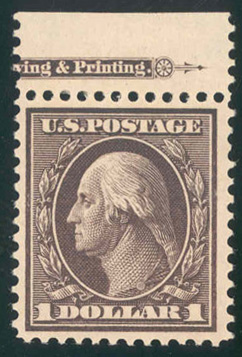
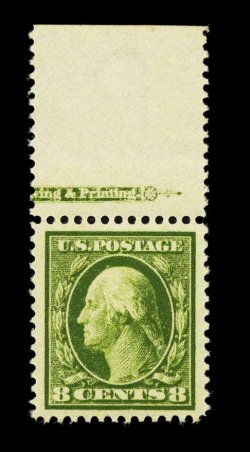

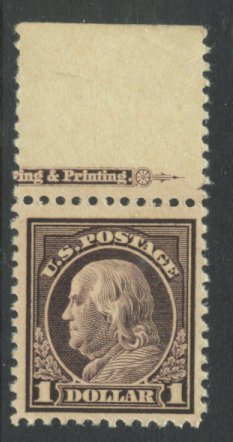
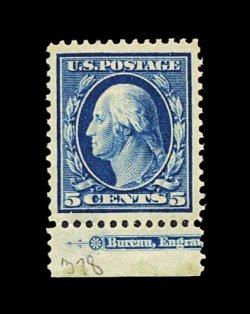
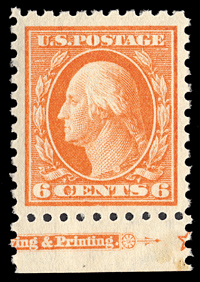
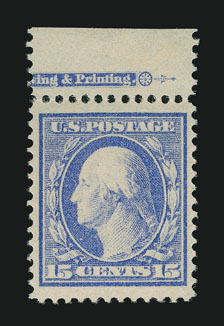
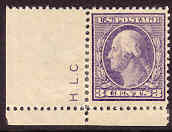 Scott
333, 3˘, H.L.C. (Harvey L. Coté). Image courtesy of Doug D'Avino.
Scott
333, 3˘, H.L.C. (Harvey L. Coté). Image courtesy of Doug D'Avino.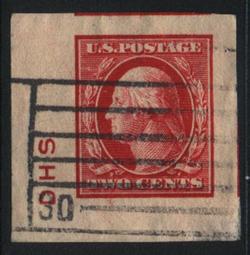 Scott
384, 2
Scott
384, 2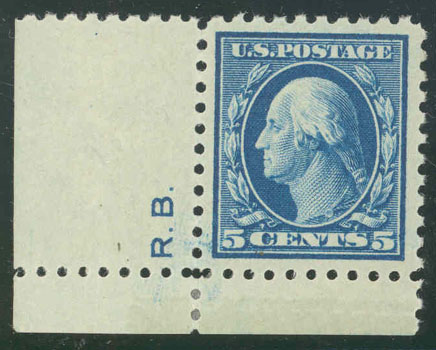 Scott
466, 5˘ R.B. (Rudolph
Bender)
Scott
466, 5˘ R.B. (Rudolph
Bender)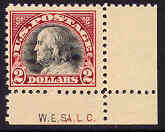

.gif)
.jpg)
.jpg)
.gif)
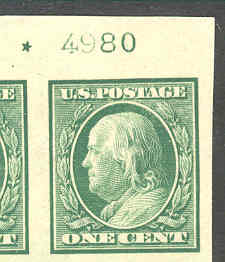
.jpg)
.jpg)

.jpg)


.jpg)
.jpg)
.jpg)
.jpg)
 .
.